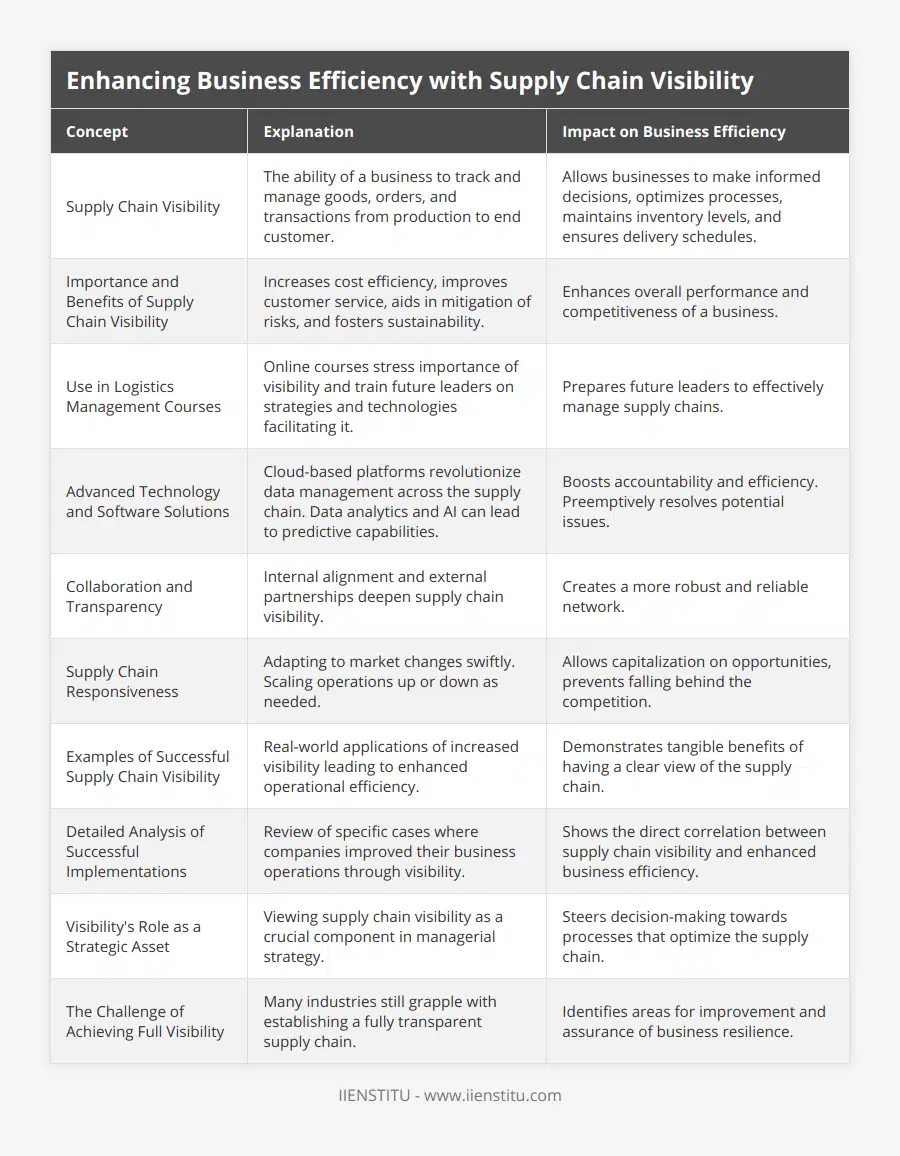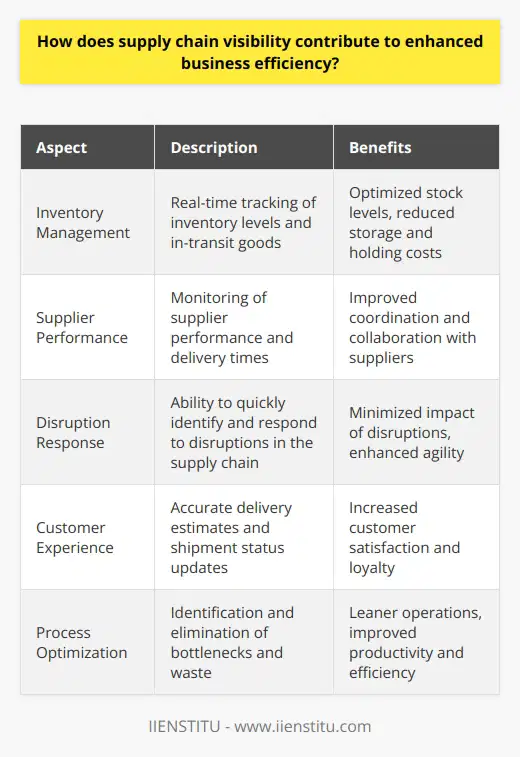
In an increasingly complex and global business environment, the significance of a transparent supply chain cannot be overstated. As organizations strive for efficiency and responsiveness, the concept of supply chain visibility proves to be a linchpin of contemporary managerial strategy. In this context, supply chain visibility is not merely an operational requirement but rather a strategic asset. However, despite its importance, many industries are still grappling with the challenges of achieving a fully transparent supply chain. Through this article, we will explore various aspects of supply chain visibility, gaining insight from case studies, and assessing future trends that are reshaping the way businesses operate.
Understanding Supply Chain Visibility
The concept of supply chain visibility encompasses the ability of a business to track and manage goods, orders, and transactions from the starting point of production to the end customer. It involves the collection, integration, and accessibility of data throughout the entire supply chain.
Explanation of Supply Chain Visibility
The ability to monitor the flow of products and information across all stages of the supply chain in real-time allows businesses to make informed decisions and respond promptly to any situation. This level of oversight becomes crucial in understanding and optimizing processes, ensuring inventory levels are maintained, and delivery schedules are met. It serves as a framework to bring together disparate parts of the supply chain, providing a cohesive, end-to-end view.
Importance and Benefits of Supply Chain Visibility
Supply chain visibility offers numerous benefits that collectively serve to enhance the overall performance and competitiveness of a business. It enables cost efficiency by minimizing waste and reducing excess inventory. Improved customer service arises from the ability to provide accurate information regarding product availability and delivery timelines. Furthermore, it aids in the mitigation of risks and disruptions by allowing companies to identify and address issues proactively. Lastly, visibility fosters sustainability by ensuring responsible sourcing and minimizing the carbon footprint through optimized logistics.
Considerations for Logistics Management Courses
To educate future leaders about the complex intricacies of supply chains, logistics management courses often stress the importance of visibility. In these online courses, students learn about the strategic advantages of having transparent processes and the technologies that facilitate this visibility. This not only includes theory but also practical, real-world applications that demonstrate the tangible benefits of having a clear view of the supply chain.
Key Elements of Supply Chain Visibility
Advancements in technology and collaborative efforts across the supply chain are essential to achieving greater visibility. These elements work in tandem to not only deliver transparency but also foster a level of responsiveness that can significantly benefit a business in a dynamic market.
Advanced Technology and Software Solutions
The advent of cloud-based platforms has revolutionized the way data is managed and shared across the supply chain. These platforms facilitate real-time tracking and management of goods and transactions, leading to greater accountability and efficiency. An understanding of data analytics plays a vital role in interpreting the vast amounts of information generated, and when combined with artificial intelligence, can lead to predictive capabilities that preemptively resolve potential issues.
Collaboration and Transparency
Internal alignment within an organization is critical to ensure that all departments are working towards the same goals with a shared understanding. Externally, establishing partnerships and alliances can enhance the depth of the supply chain visibility by integrating suppliers and logistics providers into the data-sharing process, thereby creating a more robust and reliable network.
Supply Chain Responsiveness
Supply chain visibility is not just about monitoring; it's about being agile enough to adapt to market changes swiftly. A proactive approach can often mean the difference between capitalizing on opportunities or falling behind the competition. Responsiveness entails the ability to scale operations up or down as necessary and to pivot strategies as market conditions dictate.
Case Studies and Examples of Successful Supply Chain Visibility
The real-world implications of supply chain visibility can be seen in the successes achieved by companies that have placed a high priority on this aspect of their business operations. There are noteworthy examples across various industries where increased visibility has led to significant enhancements in operational efficiency and customer service.
Detailed Analysis of Successful Implementations
One prime example includes a major retailer who leveraged cloud-based software to integrate suppliers into their inventory management system, leading to a drastic reduction in out-of-stock situations. Another instance is a global manufacturer that implemented advanced tracking technologies, reducing shipment times and improving the reliability of their delivery schedules.
Lessons Learned from these Cases
The key takeaways from these cases indicate that a well-implemented visibility strategy, supported by the right technology and a culture of collaboration, can yield impressive results. These companies provide valuable insights into how businesses can optimize their supply chain visibility, leading to better decision-making and a stronger competitive position in the marketplace.
Future Trends in Supply Chain Visibility
The journey towards full supply chain visibility continues to evolve, led by innovations in technology and driven by an increasing need for sustainability and ethical considerations in business operations.
Influence of Emerging Technologies
Blockchain technology and the Internet of Things (IoT) are poised to offer unprecedented levels of traceability and security in the supply chain. They facilitate the creation of a digital ledger that is both immutable and transparent, allowing stakeholders in the supply chain to verify the provenance and handling of goods without the risk of tampering or fraud.
Growth of Real-time Visibility and Predictive Analytics
The trend towards real-time, granular visibility, and the application of predictive analytics techniques is helping companies anticipate and navigate potential disruptions before they occur. This foresight enables better risk management and a more agile supply chain, capable of adapting to the unexpected.
Increasing Importance of Sustainability
As consumers and corporations alike become more environmentally conscious, sustainability emerges as a vital component of supply chain management. Visibility plays an essential role here, as it allows for the monitoring of eco-friendly practices and compliance with regulations throughout the supply chain, further promoting a culture of accountability.
Conclusion
This article has underlined the pivotal role of supply chain visibility as a component of modern business strategy. By allowing organizations to track movements and understand the inner workings of their supply chains, visibility fosters better decision-making, improved customer satisfaction, and enhanced operational efficiency. As such, companies are encouraged to pursue and invest in opportunities that will enhance their supply chain visibility. The benefits gleaned from a transparent supply chain are well-documented and offer a clear competitive advantage in today’s fast-paced business environment.
References
The insights discussed in this article are drawn from a broad spectrum of literature and case studies on supply chain management and visibility. These sources have provided a foundation for the analysis and recommendations presented herein, demonstrating the consensus on the value of supply chain visibility for business success in the modern economy.

Frequently Asked Questions
How does supply chain visibility contribute to enhanced business efficiency?
Supply Chain Visibility and Business Efficiency
Supply chain visibility remains a pivotal aspect of modern business management. It denotes the ability to track products and components from origin to delivery. Heightened supply chain visibility ensures companies are not blindly maneuvering through their operational processes. Instead, they gain valuable insights. These insights lead to data-driven decisions.
Understanding Visibility in Supply Chains
Visibility allows stakeholders to view inventory levels, in-transit goods, and supplier performance. Such detail is not mere operational nicety. It is now a critical necessity. Real-time data tracking ensures that all parties stay well-informed. Greater informational access streamlines key processes.
The Efficiency Catalyst
Increased Reactivity plays a significant role here. With heightened visibility, businesses can respond to disruptions swiftly. Reaction times shorten. Lost time diminishes. Improved response dynamics ensure potential issues do not spiral into crises.
Reduced Inventory Costs follow suit. Visibility allows for precise inventory management. Businesses maintain optimal stock levels. Surpluses and shortages become rare. Storage and holding costs decrease. Capital thus freed can bolster other business areas.
Heightened Customer Satisfaction is often a direct benefit. Visibility facilitates accurate delivery estimates. Updates on shipment status keep customers informed. Trust builds. Return business becomes more likely. Service quality rises. Efficiently meeting customer expectations breeds loyalty.
Leaner and More Agile Operations
Lean methodology thrives on visibility. It identifies and eliminates waste within processes. Efficiency thrives on lean principles. Visibility enables the quick detection of bottlenecks. Processes streamline. Productivity amplifies.
Agility corresponds with the ability to adapt. Visibility equips businesses to modify operations as needed. Market demands shift. Visibility ensures adaptation occurs in a timely fashion. Agile businesses outpace competitors. They capture more market share. They innovate relentlessly.
Collaborative Synergies
Visibility does not operate in a vacuum. Suppliers, manufacturers, and distributors align their efforts. Everyone benefits from shared information. Collaboration intensifies. Synergies form. The entire supply chain becomes more cohesive. Efficiency rises as a collective enterprise. Operations synchronize. They complement each other.
The Technological Leverage
Digital tools have revolutionized visibility. Technologies like IoT, AI, and blockchain make real-time data accessible. They also protect data integrity. Technology investments pay off. They return value through enhanced efficiency.
- IoT Devices give live updates on shipments.
- AI Algorithms predict demand, optimize routes.
- Blockchain ensures secure, transparent transactions.
Conclusion
In sum, supply chain visibility fosters a more responsive, lean, and collaborative environment. It leads to significant reductions in operational costs. It also boosts customer loyalty through dependable service delivery. Visibility is not a business luxury. It is a cornerstone for competitive, efficient operations. Businesses that invest in visibility are investing in their future growth.

What are the technological advancements that facilitate supply chain visibility and how do they impact overall business performance?
Supply Chain Visibility: A Tech-Driven Transformation
Understanding Supply Chain Visibility
Supply chain visibility (SCV) refers to the tracking of products and services. It begins from the origin to the final destiny. Improved visibility aids in decision-making. It enhances the operational efficiency of businesses.
Technological Pillars of Supply Chain Visibility
Advancements in technology largely drive SCV. They tackle complexities within the supply chain. We'll examine pivotal technologies below.
GPS and RFID for Real-Time Tracking
Global Positioning System (GPS) allows for real-time location tracking. Ships, vehicles, and other transport modes use GPS. This ensures updates are frequent and accurate.
- Businesses alert customers to current product status.
- Operations managers optimize routes and reduce delays.
Radio-Frequency Identification (RFID) tags add another layer of visibility. They store and retrieve data concerning tagged objects.
- Their use spans from inventory to shipping.
- RFID grants insight without a direct line of sight.
IoT and Big Data – The Dynamic Duo
The Internet of Things (IoT) is a game-changer. It interconnects devices throughout the supply chain.
- Real-time data flow is uninterrupted.
- IoT devices monitor conditions like temperature and humidity.
Big Data analytics process vast amounts of information. They extract actionable insights.
- Patterns and trends become clear.
- Businesses can predict demand and adjust supply.
Cloud Computing: Store, Share, Collaborate
Cloud computing grants expansive data storage. It facilitates information access from anywhere.
- Teams collaborate regardless of their location.
- Updates are instant and scalable.
Companies leverage cloud platforms for integrated SCV.
- Supply network partners access shared data with ease.
- End-to-end visibility becomes a reality.
Advanced Robotics and Automation
Robots and automated systems streamline operations.
- They assist in inventory management.
- Drones even contribute to monitoring shipments.
Automation reduces human error. It boosts efficiency and speeds at which goods move through the supply chain.
AI and Machine Learning: Predictive Power
Artificial Intelligence (AI) and Machine Learning (ML) refine SCV. They process data and learn over time.
- Anomalies are detected swiftly.
- AI algorithms suggest ways to optimize processes.
ML capabilities predict future demand trends. They enable businesses to anticipate and act.
Blockchain for Immutability and Trust
Blockchain technology ensures information accuracy. It registers transactions that no one can alter.
- Supply chain stakeholders trust the recorded data.
- Transparency reaches new heights.
Smart contracts on blockchain automate agreements.
- They self-execute upon meeting preset conditions.
- Efficiency rises with lesser need for verification.
Impact on Business Performance
The impact on overall business performance is vast.
- Forecasting improves with accurate, real-time data.
- Operational costs reduce through optimized processes.
There's an increase in customer satisfaction.
- Delivery times shorten.
- Trust grows with transparent transactions.
Supply chain resilience strengthens against disruptions.
- Managers react quickly to unforeseen events.
- Flexibility improves with enhanced situational awareness.
Conclusion
Technologies enabling supply chain visibility are transforming businesses. They contribute to a more sustainable, efficient, and customer-focused supply chain model. Companies that leverage these advancements position themselves ahead in the global marketplace.

Can supply chain visibility aid in risk management and mitigation during crisis situations, thereby improving business efficiency?
Supply Chain Visibility: A Shield Against Uncertainty
Supply chain visibility (SCV) plays a critical role in risk management. During crises, it becomes even more valuable. SCV refers to the ability to track products. One can follow their journey end-to-end within the supply chain. Managers gain a comprehensive view. This view proves essential for making informed decisions.
Understanding Risks Through Transparency
Transparency is the bedrock of effective risk management. It helps in identifying potential bottlenecks. Stakeholders can foresee disruptions in the chain. They can gauge the impact of such disruptions on operations. Hence, better transparency leads to stronger risk assessment capabilities.
Proactive Measures Over Reactive Responses
A visible supply chain allows for proactive strategies. It mitigates risks instead of simply reacting to them. Companies anticipate problems. They devise contingency plans ahead of crises. This approach saves time. It also reduces costs associated with knee-jerk reactions.
Collaboration and Communication Enhance Resilience
Visibility fosters collaboration among stakeholders. Strong communication networks emerge. These are essential for coordination in times of crisis. They support a unified approach to problem-solving. Thus, businesses can manage risks effectively. They also maintain operational continuity.
Data-Driven Insight Drives Decision Making
SCV provides a wealth of data. Leaders can analyze this data for insights. They understand patterns and vulnerabilities. They can make informed decisions that enhance efficiency. In a crisis, such informed decisions are invaluable.
Integration of Technology Strengthens SCV
- Advanced tracking systems
- AI and predictive analytics
- Real-time monitoring tools
These technologies deepen supply chain visibility. They enable quick responses to changing situations. Technology helps in maintaining efficient business operations. It mitigates risks in a timely manner.
Conclusion: Visibility as a Pillar of Efficiency
In conclusion, supply chain visibility is indispensable. It indeed aids in risk management and mitigation. During crises, its importance multiplies. Businesses can not only survive but also thrive. They do so by improving their response and recovery times. Visibility enhances overall business efficiency. It creates a resilient supply chain capable of weathering storms.



